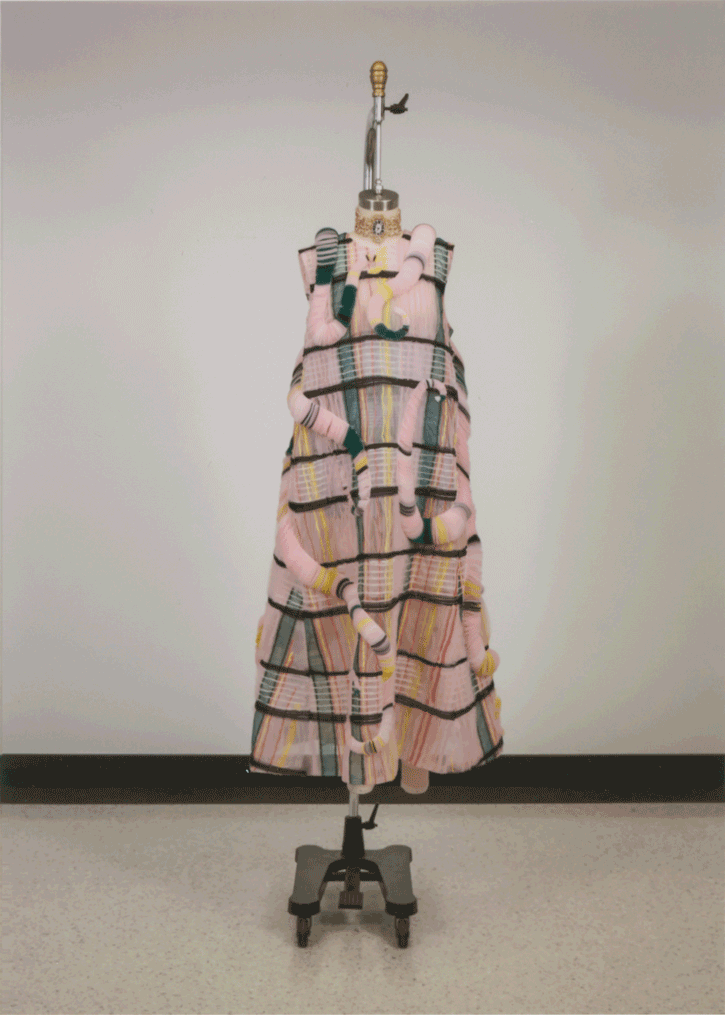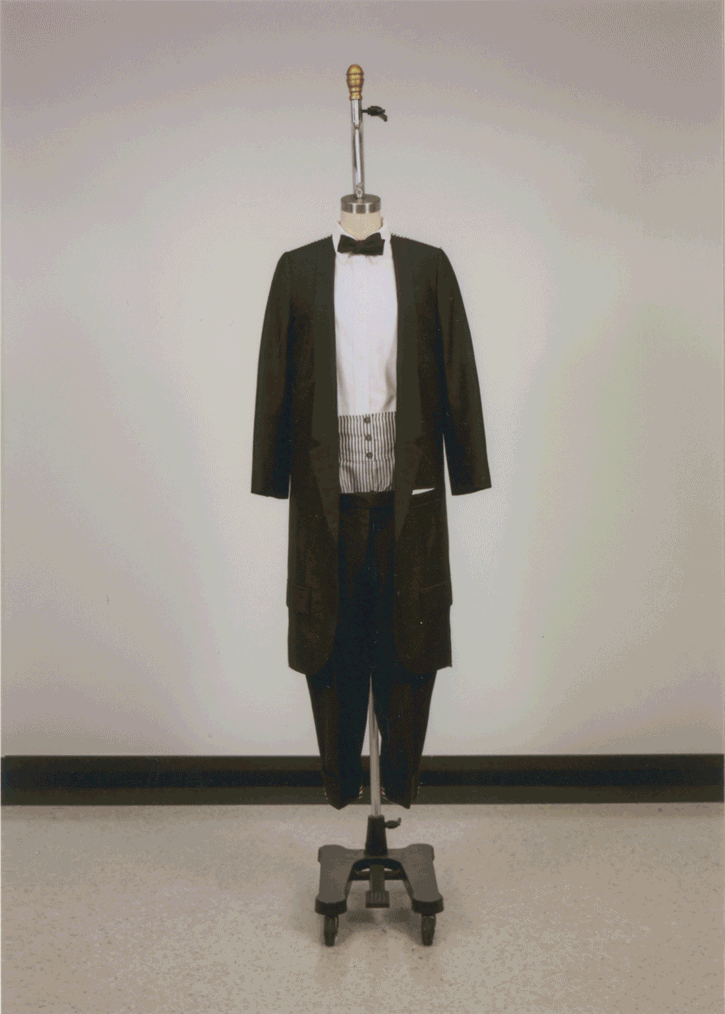
Thom Browne
Spring/Summer 2018 Womenswear - Look 19
Dutch trend guru Li Edelkoort once noted the disservice done to fashion by online coverage being the reduction of designer’s work to a series of front-on images, sequestering any and all accounts of perspective and three-dimensionality. Few modern day designers so aptly demonstrate the truth of this creative doctrine quite like the wildly innovative and technical collections of Thom Browne. The truth is, Thom Browne is an outlier in contemporary fashion, approaching his craft not like the trend-driven designers the world sees so much of today, but like a true couturier and artist.
For centuries, artists have maintained a structured approach to their discipline, producing concise bodies of work that represent a continuation of ideas and thoughts, which together generate a cohesive oeuvre distinguishing their artistic style and creative vision apart from the rest.
From the brand’s inception in 2001, Thom Browne established a succinct assortment of distinct house codes rooted in quality craftsmanship and precise tailoring, codes that he continues to revisit and build upon season-to-season. These idiosyncratic narratives include unique construction techniques, various forms of iconography, consist color pallets and methods of fabrication, trademark silhouettes, and an overarching American design sensibility.
When addressing Thom Browne’s rich archive, one must take a narrative approach to understanding how these visual and structural themes hidden within collections past, help to define Browne’s greater artistic oeuvre. In breaking down the history of the Thom Browne brand, a cohesive compilation of themes begin to emerge, relating to trompe l’oeil construction methods, animal motifs, exaggerated silhouettes and the designer’s overall nonconformist tendencies.

Thom Browne
Woven throughout each of Thom Browne’s collections are layers of intellectual references alluding to the breaking down of gender barriers. While women modeling tailored menswear has been embraced in high fashion since Yves Saint Laurent first introduced his eponymous ‘Le Smoking’ tuxedo in 1966, Browne’s creative relationship with androgynous dress often further challenges culturally accepted boundaries. From a business that began in 2001 with a small ‘by appointment’ shop in New York’s West Village offering five suits, to launching a complete women’s ready-to-wear collection in 2011, countless female models have walked Thom Browne’s runways in impeccably executed variations of the brand’s trademark jacket and trouser ensemble.
Numerous instances have since emerged where Browne further masculinizes his female subjects through dress; such was the case for spring/summer 2012, where the drop waist trousers of a tuxedo ensemble revealed black and white boxer shorts beneath. Similarly, for spring/summer 2015, the collection’s countless suit-wearing females were accessorized with complimentary ties or bowties, suggesting that women, too, deserve a proper power suit.
Thom Browne
Spring/ Summer 2012 Womenswear - Look 25
Thom Browne
Spring/ Summer 2012 Womenswear - Look 25
Thom Browne
Spring/ Summer 2015 Womenswear - Look 2
Thom Browne
Spring/ Summer 2015 Womenswear - Look 2
While society has long accepted genderless dressing on women, only recently were gender barriers in fashion truly eradicated for men, as well; a concept Browne has long been championing. From his earliest menswear shows where otherwise masculine outerwear adapted lengthy trains – recalling the extended material often incorporated in women’s formalwear – to men in ankle-length skirts for fall/winter 2007 and flapper-like fringe ensembles for spring/summer 2012. It wasn’t until Browne’s fall/winter 2012 menswear show that the designer’s deeply transgressive creative vision came to a head, with punk mavericks outfitted in studded, zipper-adorned, low-slung baby pink skirts and pastel plaid, abdomen-baring tops accessorized with safety pins. If fall 2012 was a nonconformist, punk paradise, the broad array of ‘adapted womenswear’ for Browne’s spring/summer 2018 men’s show was a purist doctrine on challenging the poles of gender norms. The collection’s unadulterated dresses, as well as pencil, maxi and pleated skirts, rendered in classic menswear materials and masculine gray wools suggested a complex dialogue between cut, fabrication and gender, further elaborated upon through each look’s heeled brogues, worn by the collection’s male models with elegance and ease.
Thom Browne
Fall/ Winter 2012 Menswear - Look 25
Thom Browne
Fall/ Winter 2012 Menswear - Look 25
Thom Browne
Spring/ Summer 2018 Menswear - Look 35
Thom Browne
Spring/ Summer 2018 Menswear - Look 35
Designers can strive their entire career and never achieve the utmost creative accomplishment of forever impacting the future of silhouette. Thom Browne is widely regarded as one of the most influential men’s wear designers of modern time, largely in part to his groundbreaking approach to cut. No single garment is more emblematic of the Thom Browne brand than the designer’s modern shrunken suits, a house signature since 2001. Beginning with his first ankle-bearing trousers and shorter-than-average cuffs, Browne has maintained a consistent relationship with exaggerated silhouettes, exploring the concept on either side of the design spectrum. From the introduction of micro-shorts for spring/summer 2008 as a unique alternative to traditional summer suiting, to the amplified shapes of Browne’s fall/winter 2014 menswear collection, where bulbous jackets with protruding shoulders and trousers resembling structured harem pants were rendered in dense, heavily embroidered brocades.
Thom Browne
Spring/ Summer 2008 Menswear - Look 18
Thom Browne
Spring/ Summer 2008 Menswear - Look 18
Thom Browne
Fall/ Winter 2014 Menswear - Look 33
Thom Browne
Fall/ Winter 2014 Menswear - Look 33
Browne’s relationship to womenswear has been equally driven by the designer’s love of extreme proportions. The bulbous shapes seen on the fall 2014 men’s runway were first introduced in the designer’s earliest women’s ready-to-wear collection for fall/winter 2011, where hourglass shapes were further exaggerated and manipulated to generate egg-like silhouettes. For fall/winter 2013 Browne’s structural paradigm was denoted by garments’ protuberant boxy shoulders; engaging a strong, structured framework as a visual queue to the collection’s powerful female message.
Thom Browne
Fall/ Winter 2011 Womenswear - Look 22
Thom Browne
Fall/ Winter 2011 Womenswear - Look 22
Thom Browne
Fall/ Winter 2013 Womenswear - Look 7
Thom Browne
Fall/ Winter 2013 Womenswear - Look 7
While iconography in fashion is most prevalent in designer’s use of logos as elements of branding, Thom Browne has established a trademark visual lexicon through his sustained allegiance to a vast assortment of animal motifs. From Browne’s now iconic ‘Hector’ handbag – named and modeled after the designer’s beloved Dachshund – to turtle backpacks, cat-shaped evening bags, and an array of runway headpieces featuring fish, bears, bunny rabbits, elephants, a disco dog, and, most recently, a variety of sea-dwelling creations worn by models in his spring/summer 2019 womenswear collection, Browne has continued to engage animal motifs as the brand’s characteristic iconography.
Thom Browne
Spring/ Summer 2013 Menswear - Look 2
Thom Browne
Spring/ Summer 2013 Menswear - Look 2
Thom Browne
Spring/ Summer 2017 Menswear - Look 31
Thom Browne
Spring/ Summer 2017 Menswear - Look 31
For spring/summer 2013, Browne presented a candy-colored menswear collection layered with lobster appliqués and countless variations of a repeated whale motif, which appeared more so as a colorful abstract pattern than an obvious school of sea-dwelling mammals. These unique icons have since reemerged in countless forms on garments throughout the designer’s spring/summer 2019 menswear collection. In spring/summer 2017, Browne revisited aquatic motifs on a number of men’s looks featuring embroidered sharks and shark fins, while the designer’s spring/summer 2018 womenswear collection – consisting of garments rendered almost entirely in tulle – included both a unicorn coat and a pastel dress revealing clutching tentacles and a sizeable octopus encircling the model’s back. While oceanic creatures are a favorite of Mr. Browne’s, the designer’s fall/winter 2017 womenswear collection put esteemed emphasis on penguins; comprised of a variety of penguin-adorned, embroidered looks reminiscent of the brand’s earliest whale-covered men’s garments.
Thom Browne
Spring/ Summer 2018 Womenswear - Look 19
Thom Browne
Spring/ Summer 2018 Womenswear - Look 19
Thom Browne
Fall/ Winter 2017 Womenswear - Look 22
Thom Browne
Fall/ Winter 2017 Womenswear - Look 22
If the intellectual theatricality of Thom Browne’s runway shows suggest concealed layers of cerebral thought, the whimsical sophistication of Browne’s artistic construction techniques add awe-inspiring, accessible inventiveness to each collection. From the minutely detailed, fabric assemblages molded out of classic Americana materials for the designer’s spring/summer 2015 collection, where robotic male figures paraded the designer’s runway in couture-level garb, to the brand’s fall/winter 2017 menswear show, where Browne re-imagined the classic gray suit, through an onslaught of interpretations that included a number of entirely flattened, exaggerated cubist garments that felt as though elements of Picasso’s Guernica came alive for a short moment in time.
Thom Browne
Spring/Summer 2015 Menswear - Look 20
Thom Browne
Spring/ Summer 2015 Menswear - Look 20
Thom Browne
Fall/ Winter 2017 Menswear - Look 17
Thom Browne
Fall/ Winter 2017 Menswear - Look 17
Likeminded artistic construction methods have assumed Thom Browne’s womenswear shows, most notably through the designer’s commitment to various forms of trompe l’oeil and techniques of visual illusion. For spring/summer 2016, Browne showed a collection based on classic tailoring, with a myriad of collaged and embroidered motifs enveloping the layered, jacket and skirt ensembles worn by each female model. The following spring season, Browne presented a collection of 31 trompe l’oeil, mostly pastel dresses, composed of a range of materials, rendered with a variety of visual attributes, from seemingly layered jackets and dangling belts, to flattened bows and a mirage of pleats. The manner in which Thom Browne is able to alchemize his intellectual thoughts and sophisticated construction techniques into alluring garments and succinct narratives has been a paradigm of his artistic genius since his brand’s earliest days.


